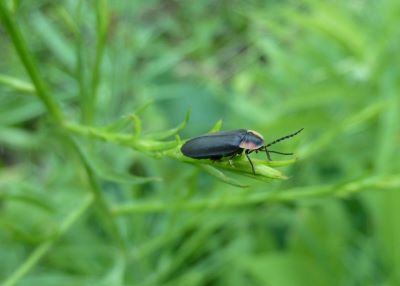
Good Natured: Daytime Fireflies
Last week we took a Good-Natured look at fireflies, those flashy stars that light up our warm summer nights. We talked about their life cycle, how to tell males from females, and mentioned a few of the more common species that can be found in our area.
But what we didn't touch upon--in fact, what hardly ever gets talked about--is that our region also has a few other types of fireflies that don't light up at all. They're not injured; they're not shy. They simply lack, or have greatly reduced, light-producing organs…the feature for which their entire family, Lampyridae, is named.
I know. Weird, huh?
Like flightless birds and hairless mammals, lightning bugs without lights are one of nature's anomalies. But unlike ostriches, kiwis and naked mole rats--all of which have had their moments in the limelight—our local diurnal, or daytime-active, fireflies go about their business relatively unnoticed.
It''s a shame, really, because diurnal fireflies are every bit as interesting as their nocturnal counterparts. Their larvae are carnivorous. Adults feed on plant nectar. They communicate, not with light but rather with pheromones, their antennae twitching and contorting as they share chemical messages. They even mate in broad daylight. Yet hardly anyone pays any attention.
I suppose I'm as guilty as anyone when it comes to overlooking these little guys.
Every summer for 20 years we've hosted programs celebrating fireflies. We've talked at length about how important fireflies are to local ecosystems. We've shown how their larvae provide needed control of invertebrate pests. Yet we have never, ever held one of these programs during the day.
Despite our lack of attention to their activities, or perhaps because of it, diurnal fireflies appear to be thriving. There are no contests to see who can find the most. No one is collecting them in jars; no one is accidentally squishing them. They're just free to be who they are, unflashy and inconspicuous, yet so important to our local ecology.
I'll bet you've seen diurnal fireflies and didn't realize it, thinking they were just nocturnal individuals resting out in the open. Although a tad smaller, diurnal species look similar to their nighttime cousins. Each has a yellow and orange pronotum, which looks like the head but actually is the plate that covers the head and thorax. Each also has dark elytra, or wing covers.
One big difference though is in the eyes. Nocturnal species rely on sight for their love connections, so their eyes are quite large. Diurnal species, on the other hand, use chemical cues in the form of pheromones, so their eyes are less prominent.
The other day I took a walk through the Hickory Knolls Natural Area and was positively stunned at the number of diurnal fireflies that were out and about. Conditions were warm, humid and overcast, which may have contributed to the insects' increased activity levels. While their nocturnal cousins are naturally protected from the sun's drying rays, diurnal fireflies have to be careful of desiccation. For this reason they tend to hang out in moist environments--woodland edges, at the base of plants, along fallen logs. Most of the ones I saw were, for some reason, on goldenrod leaves.
(Fun fact: Diurnal fireflies are so prevalent within the HKNA that they actually merited a character in the walk-and-read story Hickory Knolls: A History of Our Home. Dottie the Diurnal Firefly helps the main character, Harley the Hawk, explain to his wildlife friend that change over time can be a good thing.)
While it's possible to notice some differences between individuals, identifying diurnal fireflies to species is something I have yet to attempt. But I did, through some casual on-line research, notice an interesting trend. Even though diurnal fireflies are not known for flamboyant displays of light, their scientific names make it sound like they're only a few blinks shy of signal flares and skyrockets:
- Lucidota is from the Latin word lucidus, which means “bright, shining, clear" (Adults may glow briefly after emerging from the pupal stage.)
- Ellychnia is from the Greek word lychnos, which means “lamp"
- Pyropyga is from Greek words that mean “fire butt" (Light organs in this group are diminished, but not entirely absent.)
Lightning bugs—the night-time variety—will be with us through the month of July, provided we get some decent rain. Day-active species, by contrast, can remain active well into August and sometimes September. If bright and flashy just isn't your style, if spark and glitz don't put a twinkle in your eye, maybe it's time you gave diurnal fireflies a try.
Pam Otto is the outreach ambassador for the St. Charles Park District. She can be reached at potto@stcparks.org.

